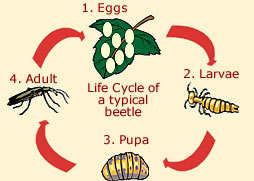Bombardier Defense
Biology 342 Fall 2012
Authors: Jacob Kraus, Claire Brumbaugh-Smith
| Home | Phylogeny | Ontogeny | Mechanism | Adaptive Value | References | Course Home |
Ontogeny
Chemical Development
There is little research on the ontogeny of the bombardiers’ defense mechanism. One study has shown that the chemicals compounds present in the defense mechanism differ based on the beetles' habitat. As mentioned in the mechanism section, subtropical beetles tend to use formic acid while temperate beetles tend to use carboxylic acids, quinone and phenols. (Giglio, Brandmayr et al. 2011) This may be due to the different diets of beetles in different areas, similarly to the varying levels of Echis snake venom toxicity based on food source (Richards, Barlow et al. 2012) 
Life Cycle
From larva to pupa to adult, bombardier beetles undergo a developmental period of roughly 20-30 days. Interestingly the beetles undergo parasitic development. As an adult, the beetle displays no parasitic behavior. The beetle egg laying process occurs not within a host species, but in the soil. When the larva hatches however, the parasitism commences. In one study, the larva of two species (Brachinus explodens and Brachinus crepitans) were found to parasitize the pupa of another species of beetle (Amara). Upon finding the Amara, the bombardier larva injure the Amara and feed off of the fluids secreted from the wound. Within two days, the Amara was completely eaten by the bombardier beetles. (Saska and Honek 2004)